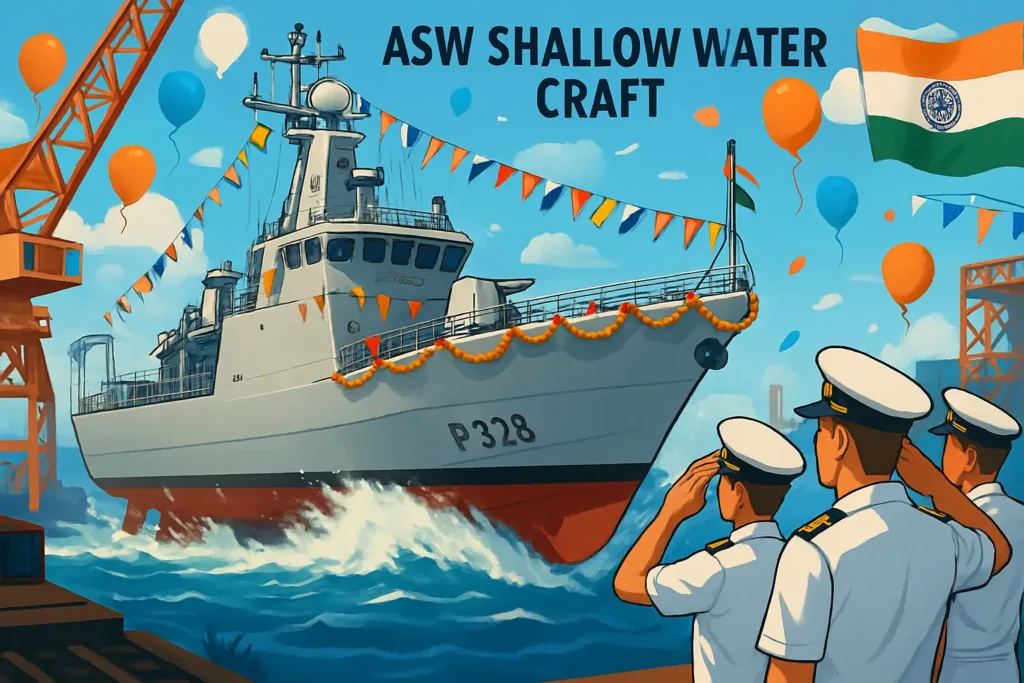
⚓🇮🇳 INS Ajay Launched: Final Anti-Submarine Warfare Craft Sets Sail into Indian Naval History
🛡️ A New Wave of Maritime Defense
India took a major step forward in its maritime defense capabilities with the launch of INS Ajay, the eighth and final Anti-Submarine Warfare Shallow Water Craft (ASW-SWC), on July 22, 2025. The vessel was ceremonially launched at the Garden Reach Shipbuilders & Engineers Ltd. (GRSE) facility in Kolkata — a moment steeped in pride, tradition, and national security ambitions.
The launch of ‘Ajay’ marks the completion of Project ASW-SWC, a flagship defense project of the Indian Navy aimed at securing India’s vast 7,500 km-long coastline against underwater threats like enemy submarines and unmanned underwater vehicles.
🛠️ What Is the ASW-SWC Class?
The ASW-SWC (Anti-Submarine Warfare – Shallow Water Craft) is a specialized class of naval ships intended for the detection, tracking, and neutralization of hostile submarines in shallow coastal waters. Unlike larger destroyers or frigates, these compact vessels are highly maneuverable, silent in operation, and capable of operating close to shore, where conventional sonar systems struggle due to ocean noise, sediment, and topography.
🌊 Key Capabilities of ‘Ajay’ and Her Sister Ships:
🛰️ Sonar and Surveillance Systems: Indigenous high-frequency sonar to detect submarines, torpedoes, and underwater drones.
🎯 Precision Weapons: Lightweight torpedoes, depth charges, rocket launchers, and anti-submarine mortars.
💡 Stealth Features: Designed with acoustic and radar-reducing technologies for low detection.
🖥️ Integrated Bridge Systems: Full digitization and automated combat management systems.
⚙️ Hull Design: Streamlined for quick movement and reduced underwater noise signatures.
🔍 Strategic Purpose: Why India Needs ASW Crafts
With the rise of submarine-based threats in the Indian Ocean Region (IOR), including from adversarial navies and non-state actors, India’s need for effective littoral zone defense has become urgent. Shallow coastal waters, especially near vital installations like ports, naval bases, and oil terminals, are vulnerable entry points for underwater intrusions.
INS Ajay and her fleet:
🔒 Provide round-the-clock underwater surveillance.
🛡️ Safeguard sea lines of communication (SLOCs).
🐟 Operate in difficult hydrographic zones like creeks, estuaries, and harbors.
🚢 Act as force multipliers for India’s maritime forces, enhancing both peacetime patrol and wartime strike capabilities.
📜 Historical Significance: The Legacy of ‘Ajay’
The name ‘Ajay’, meaning invincible in Sanskrit, carries a proud legacy in Indian naval history. The previous INS Ajay (P34) was a Soviet-built warship commissioned in 1961 and served with distinction during the 1965 and 1971 Indo-Pak wars, playing a key role in naval blockades and escort missions. Decommissioned in 2019, she now lends her name to this modern successor.
The new INS Ajay, built indigenously, symbolizes not just continuity but transformation—from dependence to self-reliance.
🏗️ Project ASW-SWC: A Model of Make in India
The project was awarded in April 2019 to GRSE, one of India’s oldest and most successful shipyards. Valued at ₹6,311 crore, it involves the construction of eight state-of-the-art vessels, all of which have now been launched.
🔧 Indigenous Contributions:
🧩 Over 80% local content, including steel, electronics, and propulsion systems.
🛠️ Participation of over 200 MSMEs and startups in component manufacturing.
🧑🏭 Employment generated across defense PSUs, private contractors, and maritime institutes.
This project is a shining example of the ‘Aatmanirbhar Bharat’ (Self-Reliant India) vision and contributes to India’s growing reputation as a shipbuilding hub in the Indo-Pacific.
⚓ Deployment and Operational Strategy
Once sea trials are completed, INS Ajay will join her seven sister ships — Arnala, Androth, Anjadip, Argal, Arnala II, Amrit, and Agrim — in full operational duty. The Navy plans to station these crafts strategically across critical naval zones, including:
🌐 Arabian Sea (West Coast)
🌐 Bay of Bengal (East Coast)
🛟 Andaman & Nicobar Command
🛰️ Naval bases near critical shipping lanes
They will serve as first responders to underwater threats, escort high-value naval assets, and operate jointly with frigates, corvettes, and submarines during military exercises and real-time deployments.
📸 The Launch Ceremony: A Symbol of Progress
The launch was attended by senior officials from the Indian Navy, Ministry of Defence, and GRSE. The ceremonial breaking of the coconut on the ship’s hull was followed by patriotic salutes and the raising of the Indian tricolor 🇮🇳.
Speaking on the occasion, Navy officials remarked:
“With INS Ajay, India closes a critical gap in coastal defense. These crafts are silent guardians—always watching, always ready.”
🌍 Regional Context: The Indo-Pacific Challenge
India’s expanding naval strength is also a strategic counterbalance to increasing maritime competition in the Indo-Pacific, where China’s submarine activity is on the rise. By improving surveillance and strike capability in shallow waters, India is signaling its resolve to safeguard sovereignty and trade routes across the Indian Ocean.
🧠 Expert Opinion: A Strategic Win
Defense analysts hail the ASW-SWC program as a landmark achievement. According to naval expert Cdr. Arun Prakash (retd):
“These ships offer unmatched agility and stealth in our immediate maritime backyard. In modern hybrid warfare, the ocean floor is a battleground—and Ajay is India’s frontline warrior.


